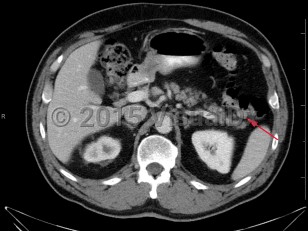Colonic polyps
Alerts and Notices
Important News & Links
Synopsis

A colonic polyp is an endoscopically visible mucosal protrusion that may be classified as a non-neoplastic hamartoma or juvenile polyp, a hyperplastic mucosal proliferation, a hyperplastic polyp, or an adenomatous polyp. Most colorectal cancers arise from adenomatous polyps. Approximately 30% of adults in middle-age and approximately 50% of adults aged 70 and older have adenomatous polyps, although less than 1% of these polyps will develop into cancer. The risk of an adenomatous polyp developing into cancer depends on its size, shape, and histology. Adenomatous polyps may be pedunculated (attached by an elongated stalk of tissue) or sessile (without stalk); sessile polyps are more likely to develop into colorectal adenocarcinoma.
Histologically, polyps may be tubular, villous, or tubulovillous. Villous adenomas are 3 times more likely to become malignant than tubular polyps. The likelihood that a polyp contains invasive cancer increases with the size of the polyp. Most polyps remain asymptomatic and are detected during routine screening colonoscopy. Less than 5% of polyps lead to bleeding.
Once an adenomatous polyp has been detected, the entire colon should undergo surveillance for polyp detection. Colonoscopy should be repeated based on the number and histology of previously discovered polyps. Family history and certain disease processes (eg, ulcerative colitis, familial adenomatous polyposis) can impact surveillance colonoscopy recommendations as well.
Histologically, polyps may be tubular, villous, or tubulovillous. Villous adenomas are 3 times more likely to become malignant than tubular polyps. The likelihood that a polyp contains invasive cancer increases with the size of the polyp. Most polyps remain asymptomatic and are detected during routine screening colonoscopy. Less than 5% of polyps lead to bleeding.
Once an adenomatous polyp has been detected, the entire colon should undergo surveillance for polyp detection. Colonoscopy should be repeated based on the number and histology of previously discovered polyps. Family history and certain disease processes (eg, ulcerative colitis, familial adenomatous polyposis) can impact surveillance colonoscopy recommendations as well.
Codes
ICD10CM:
K63.5 – Polyp of colon
SNOMEDCT:
68496003 – Polyp of colon
K63.5 – Polyp of colon
SNOMEDCT:
68496003 – Polyp of colon
Look For
Subscription Required
Diagnostic Pearls
Subscription Required
Differential Diagnosis & Pitfalls

To perform a comparison, select diagnoses from the classic differential
Subscription Required
Best Tests
Subscription Required
Management Pearls
Subscription Required
Therapy
Subscription Required
References
Subscription Required
Last Reviewed:04/19/2017
Last Updated:04/19/2017
Last Updated:04/19/2017

